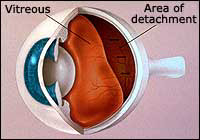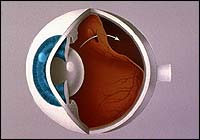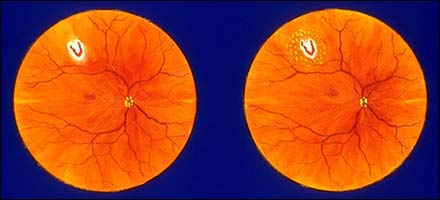The center of the eye is filled with a jelly-like substance called “vitreous.” At a young age, this substance is very thick with a consistency somewhat like “Jell-o”. As a natural process of aging, the vitreous becomes more liquefied as one gets older. The vitreous is usually completely attached to the retina, which is the seeing membrane in the back of the eye.

The vitreous jelly has pulled away from the retina in the back of the eye.
As the vitreous becomes progressively liquefied, it begins to move around inside the eye. Eventually, the vitreous becomes so loose that it “pulls away” from the retina behind it. This is called a “vitreous detachment” and is a result of a natural process of life. Some people get this in their 30’s and 40’s but usually the process occurs after age 50.
As the vitreous pulls away from the back of the eye, sometimes small pieces of the vitreous “break away” and float inside the liquefying jelly. These are “floaters” and appear as black spots or specks in your vision that often move around, especially with eye movement. As the vitreous continues to detach, these floaters usually settle to the bottom of the eye and become less bothersome. Sometimes, it takes several months for the symptoms to improve. There is no medication, glasses, or surgery that will make these symptoms improve faster.

A retinal detachment can occur by creating a tear in the retina shown by the arrow. The tear occurs as the vitreous jelly pulls the retina while detaching from the retina. Fluid inside the eye goes through the newly created hole (see arrow) and the fluid pulls the rest of the retina off the back of the eye (Retinal Detachment)
Rarely, the retina behind the vitreous can be pulled as the vitreous detaches producing a “retinal detachment” or a tear in the retina. This could require laser or other surgical treatment to prevent the tear from enlarging and pulling the retina away from the back of the eye, which would require more extensive treatment. Your retina should be examined if you have any of the following symptoms:
- Onset of floaters or increase in number of floaters.
- Any association with flashing lights in your peripheral or “side” vision, or an increase in flashing lights.
- A black curtain covering your peripheral vision and coming from above, below, or from the side. You can check each eye by covering one eye at a time.

Sometimes tears in the retina are treated with laser surgery. At the left, a retinal tear is present shaped like a horseshoe! At the right, laser application surrounding the tear seals down the tear preventing it from getting bigger and allowing for resorption of fluid beneath the retina.